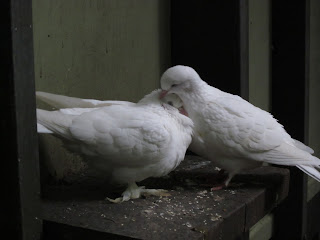Birds grow up at astonishing speed. If we were the same we would complete our entire education and be married in six months flat.
The photo shows two doves that were eggs only a few months ago. Now they are fully grown and have chosen a mate. The one with the well-feathered feet I have dubbed BigFeet2, because the feathers make her feet look big (I think she is a female), and because there is another dove amongst the twenty-one that now live in this forest that also has well-feathered feet, albeit not so much, but was born before BigFeet2, which I call BigFeet1.
The photo shows the male bird (if I am right about gender) grooming his beloved.
My guess about their genders is based on seeing BigFeet2 mounted by her mate. That seems conclusive, but BigFeet2 also does the cooing and bowing behaviour typical of males, although that may only be the warning cooing that means 'Move over, that food is mine!' But I expect they know which is which, and there will in due course be eggs then the flutter of smaller wings.
As I write this the pair are wandering, and occasionally flying, round my office.
But a few days later, as if they knew my doubts about their genders and wanted to put me right, they made their beautiful fluttering unions three times on the floor of my office, and BigFeet2 was on top every time. So he is a he. And his mate spends more time grooming him that he spends on her, which makes it conclusive.
:-)
The photo shows two doves that were eggs only a few months ago. Now they are fully grown and have chosen a mate. The one with the well-feathered feet I have dubbed BigFeet2, because the feathers make her feet look big (I think she is a female), and because there is another dove amongst the twenty-one that now live in this forest that also has well-feathered feet, albeit not so much, but was born before BigFeet2, which I call BigFeet1.
The photo shows the male bird (if I am right about gender) grooming his beloved.
My guess about their genders is based on seeing BigFeet2 mounted by her mate. That seems conclusive, but BigFeet2 also does the cooing and bowing behaviour typical of males, although that may only be the warning cooing that means 'Move over, that food is mine!' But I expect they know which is which, and there will in due course be eggs then the flutter of smaller wings.
As I write this the pair are wandering, and occasionally flying, round my office.
But a few days later, as if they knew my doubts about their genders and wanted to put me right, they made their beautiful fluttering unions three times on the floor of my office, and BigFeet2 was on top every time. So he is a he. And his mate spends more time grooming him that he spends on her, which makes it conclusive.
:-)
